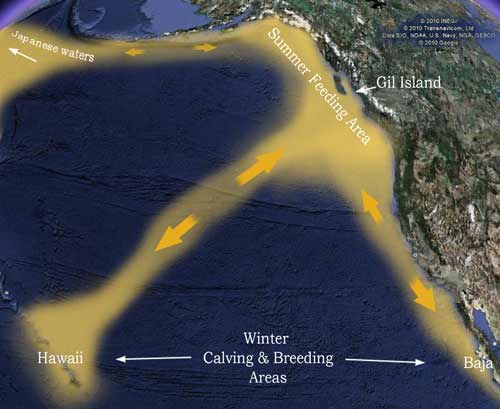Migration
Humpback whales are found in all oceans and they all follow the same migrational pattern from summer feeding grounds to warmer waters in winter for calving and possible mating. Every fall we know that one by one the humpback whales that have filled our days will slowly begin their annual migration south. Some will travel to a group of islands east of Japan and another group to the Baja.  The largest concentration that we know of , over 60%, will travel to Hawaii. The migration will take them from 4 to 8 weeks to complete. This distance of about 3000 miles each way is one of the longest known migrations of any mammal. While in these winter ground mothers will give birth to and nurture their calves. The males will continue to sing their world famous song and compete for the attention and possible mating of a female.
The largest concentration that we know of , over 60%, will travel to Hawaii. The migration will take them from 4 to 8 weeks to complete. This distance of about 3000 miles each way is one of the longest known migrations of any mammal. While in these winter ground mothers will give birth to and nurture their calves. The males will continue to sing their world famous song and compete for the attention and possible mating of a female.
We have noticed that the first whales to leave the northern feeding grounds are the younger juveniles. The last too leave are females we assume are pregnant and will need as much nutrition as possible to make the long journey south and then back with her new young calf. During her entire time in southern waters she will not be feeding so you can imagine how important her last meals here will be. A mother humpback must nurse her new calf immediately after birth, though she herself has been fasting during the entire migration. It is estimated that a calf needs 100 gallons of fat milk every single day! She is able to provide this for her calf for months before she returns here to replenish here storage of blubber. When she arrives here in early spring she will have lost over a 1/3 of her body weight! This is an indication of how vital and important this northern feeding ground is for whales.

 Migration
Migration